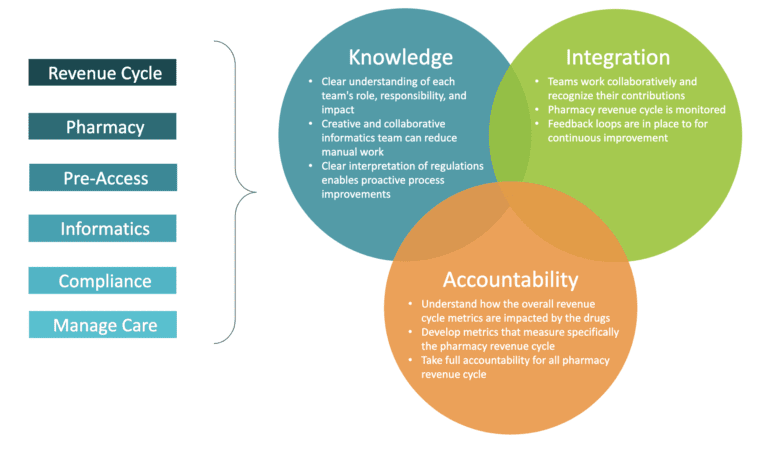3 Common Pharmacy Revenue Cycle Challenges And How To Tackle Them
Maxie Friemel and Heather Schrant
It’s clear that pharmacy is no longer just a cost center but a key revenue driver for health systems. That’s why it is more important than ever to understand how your pharmacy revenue cycle is functioning and what you can do to optimize it.
The average denial rate for a medical claim is 5-10%*. Medical billing, especially for high-cost medication infusions, is a highly specialized function many healthcare professionals don’t fully understand. And medical benefits can overlap with many other service lines, including specialty pharmacy, infusion services, and the supply chain, including 340B. But when you evaluate and optimize the pharmacy revenue cycle, all those complex components should pull together to drive maximal value for the organization.
Here are the three biggest pharmacy revenue cycle challenges our clients face today and how we’re helping them address those issues.
1. Pharmacy basics are becoming more complex – and harder to manage.
Basic pharmacy tasks, like tracking new drugs from formulary and applying the correct electronic medical record (EMR) build and coding, have become more difficult to handle. In particular, we’re beginning to see a sharp increase in brand-specific Healthcare Common Procedure Coding System (HCPCS) codes. As a result, what was once a basic and easy function is now becoming more challenging for health systems.
The consequences of poor coding maintenance can be steep. Just one coding error on a single drug can leave organizations with millions of dollars on the table. To mitigate the revenue leakage associated with pharmacy coding errors, it’s critical to have the right monitoring system in place so that you can quickly identify and correct errors. Regular audits that capture all angles of the process are also essential.
Health systems’ ability to maintain the mid-cycle will be more critical than ever in 2024. And, as basic coding tasks continue to become more complex, pharmacy operations and revenue cycle teams will need to collaborate closely to ensure the process is clean and optimized.
2. If you don’t understand your managed care contracts, you’re likely leaving dollars on the table.
Managed care contracting is another area that is emerging as a key opportunity to enhance the pharmacy revenue cycle. Health systems need to understand how drugs are getting paid for – not only in terms of medical benefits but specialty benefit carve-outs as well.
You can often uncover areas of waste simply by better understanding the mechanics of these managed care contracts. For example, your contract requirements could be driving site of care (SOC) issues that require specialty infusion services to be referred outside the organization. Or conversely, you might be spending lots of time managing SOC issues that aren’t making any difference in your contracts.
Pharmacy and managed care contracting are interconnected. That’s why it’s important to have clear communication with these two teams to ensure alignment between your contracts and your pharmacy operations.
3. Creating an integrated pharmacy revenue team can be challenging – but it’s the glue that brings everything together.
When you establish a highly integrated pharmacy revenue cycle team, you’re bringing all stakeholders to the table and assuring that highly specialized work is performed by the right team members. These teams need to be integrated across pharmacy, revenue cycle and managed care contracting due to the increasing complexity and ever-changing regulations surrounding the reimbursement of high-cost medications.
However, this task is easier said than done, and it’s typical to see a lot of finger-pointing as you begin the integration process. But the pain is worth the gain. Because a pharmacy revenue cycle team that’s truly integrated has accountability to fix processes regardless of where they reside in the organization or who is involved with them.
The holy grail of an integrated pharmacy revenue cycle team is its ability to drive cross-functional strategic alignment. When you have got the right pharmacy experts at the table helping to drive your organization’s strategy and key decisions, significant improvements in net revenue are quickly achieved.
Elements of an integrated pharmacy revenue cycle team


To learn more, read our full summary of the top 10 issues facing health system pharmacy in 2024.
Here at Visante, we help health systems accelerate strong financial and operational performance through pharmacy. Our team’s innovative approach can help you optimize your fully integrated health system pharmacy program. Contact us by emailing solutions@visante.com or calling (866) 388-7583 to speak to one of our team members.
*Source: HFMA Modern Healthcare
